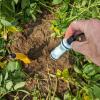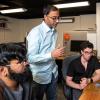Research Feature
 PhD student Laura Shannon, alongside Professors Greg Rieker and Peter Hamlington of the Paul M. Rady Department of Mechanical Engineering are setting fires inside wind tunnels to gain a better understanding of how fire spreads across different terrain. The team says their findings could help keep communities safer in a world where climate-driven wildfire is becoming more common—and more dangerous.
PhD student Laura Shannon, alongside Professors Greg Rieker and Peter Hamlington of the Paul M. Rady Department of Mechanical Engineering are setting fires inside wind tunnels to gain a better understanding of how fire spreads across different terrain. The team says their findings could help keep communities safer in a world where climate-driven wildfire is becoming more common—and more dangerous. Soil is comprised of an intricate network of bacteria and other microbes that humans depend on, but this complex environmental system is constantly shifting, making it difficult for scientists to measure. Associate Professor Gregory Whiting and his team of researchers are developing reliable, inexpensive and easy-to-deploy sensors that monitor soil in real time to help farmers optimize their use of fertilizers, reduce greenhouse gas emissions and save money in the process.
Soil is comprised of an intricate network of bacteria and other microbes that humans depend on, but this complex environmental system is constantly shifting, making it difficult for scientists to measure. Associate Professor Gregory Whiting and his team of researchers are developing reliable, inexpensive and easy-to-deploy sensors that monitor soil in real time to help farmers optimize their use of fertilizers, reduce greenhouse gas emissions and save money in the process. Assistant Teaching Professor James Harper recently led a behavioral study analyzing toilet use in Cambodia. Their goal was to introduce a new, smart toilet design that can keep rural households safe and protect the environment. But while households reported that they liked the new system, a crucial piece was missing: using it correctly.
Assistant Teaching Professor James Harper recently led a behavioral study analyzing toilet use in Cambodia. Their goal was to introduce a new, smart toilet design that can keep rural households safe and protect the environment. But while households reported that they liked the new system, a crucial piece was missing: using it correctly. Research Professor Jacob Segil collaborated with Dr. Omer Mei Dan from the University of Colorado Anschutz School of Medicine to create a redesigned surgical instrument called the CAP-LIFT cannula. The device was recently launched in October, and within the first few weeks used in over 100 successful surgeries.
Research Professor Jacob Segil collaborated with Dr. Omer Mei Dan from the University of Colorado Anschutz School of Medicine to create a redesigned surgical instrument called the CAP-LIFT cannula. The device was recently launched in October, and within the first few weeks used in over 100 successful surgeries. Assistant Professor Nicole Xu first became fascinated with moon jellyfish more than a decade ago because of their extraordinary swimming abilities. Today, Xu has developed a way to harness their efficiency and ease at moving through the water in ways that could make some types of aquatic research much easier.
Assistant Professor Nicole Xu first became fascinated with moon jellyfish more than a decade ago because of their extraordinary swimming abilities. Today, Xu has developed a way to harness their efficiency and ease at moving through the water in ways that could make some types of aquatic research much easier. Associate Professor Nathalie Vriend is leading a research effort exploring how sand dunes evolve over time, shifting and surging across the landscape. Her team ultimately wants to answer a pressing question: Can humans efficiently shift or even halt the flow of the planet’s largest dunes?
Associate Professor Nathalie Vriend is leading a research effort exploring how sand dunes evolve over time, shifting and surging across the landscape. Her team ultimately wants to answer a pressing question: Can humans efficiently shift or even halt the flow of the planet’s largest dunes? Left ventricular assist devices (LVAD) designed to improve blood flow throughout the body can aid nearly 26 million people globally struggling with heart failure. But these implantable devices come with risks. New research by Assistant Professor Debanjan Mukherjee suggests that studying patient blood flow patterns could help determine who’s at risk of dangerous side effects from LVADs and lead to improvements that could make them safer.
Left ventricular assist devices (LVAD) designed to improve blood flow throughout the body can aid nearly 26 million people globally struggling with heart failure. But these implantable devices come with risks. New research by Assistant Professor Debanjan Mukherjee suggests that studying patient blood flow patterns could help determine who’s at risk of dangerous side effects from LVADs and lead to improvements that could make them safer. Learn the latest in research and innovations in the College of Engineering and Applied Science.
Learn the latest in research and innovations in the College of Engineering and Applied Science. Assistant Professor Longji Cui and his team in the Cui Research Group have developed a new technique that allows them to measure phonon interference inside of a tiny molecule. They believe one day, this discovery can revolutionize how heat dissipation is managed in future electronics and materials.
Assistant Professor Longji Cui and his team in the Cui Research Group have developed a new technique that allows them to measure phonon interference inside of a tiny molecule. They believe one day, this discovery can revolutionize how heat dissipation is managed in future electronics and materials. CU Engineering faculty and researchers are nationally recognized for excellence in research, scholarship and innovation, earning prestigious honors from the National Science Foundation, Department of Defense, National Academy of Engineering and National Academy of Inventors.
CU Engineering faculty and researchers are nationally recognized for excellence in research, scholarship and innovation, earning prestigious honors from the National Science Foundation, Department of Defense, National Academy of Engineering and National Academy of Inventors.

